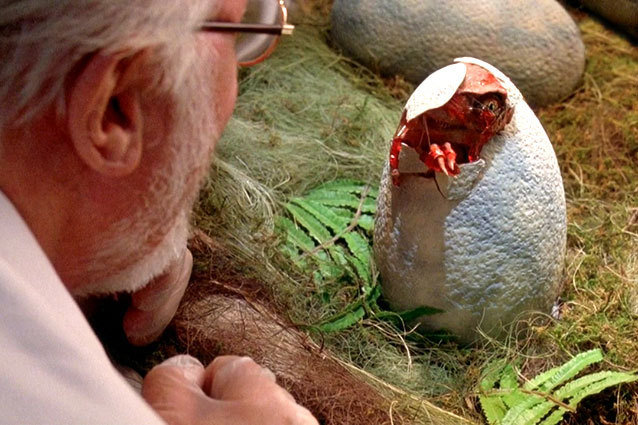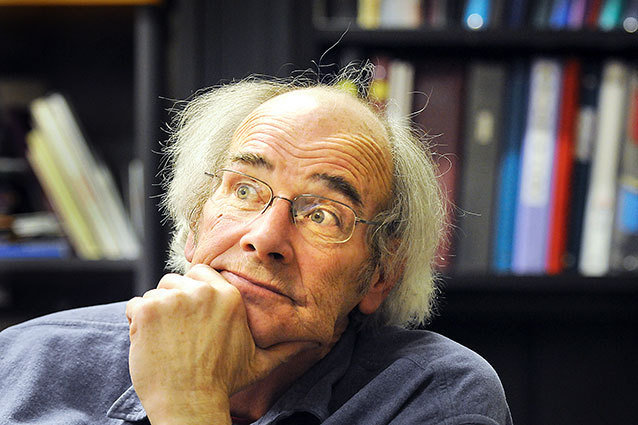
In 1993, Jurassic Park learned a lot from Jack Horner. The Montana State University paleontologist advised Steven Spielberg and crew on the set of the Michael Crichton adaptation on the true behavior of some of the prehistoric era’s most friendly and frightening species. But Horner also learned a lot from Jurassic Park. So much, in fact, that the professor began work on bringing those friendly and frightening species to life off the screen. “The whole idea of making a dinosaur came from [Crichton’s] original idea,” Horner tells Hollywood.com. “I kept thinking, ‘There’s got to be a way to do this.'”
So after shooting on the film wrapped, Horner — along with some ambitious graduate students — got to work on recreating a dinosaur. They tried extracting DNA from a Tyrannosaurus Rex specimin, but that turned out to be as helpful as hiding from a Tyrannosaurus Rex in a flimsy bathroom. Instead, almost two decades after Spielberg’s classic screened in theaters, Horner realized the easiest way to bring dinosaurs back to life was to create a dino-chicken. And if you’re thinking that sounds like a chicken that’s been retrofitted to look like a dinosaur, you’d be exactly right.
RELATED: De-Extinction Could Create a Real ‘Jurassic Park’
It’s not as crazy as it sounds. After all, Horner’s process, which involves the paleontologist genetically modifying chicken eggs, is an accelerated form of breeding that targets DNA instead of reproduction. And chickens — along with all birds — are aready equipped with dinosaur DNA, making their eggs the cheapest option for Horner’s experiments. “We really don’t have to do anything because they’re already a kind of a dinosaur,” Horner says. “[But] sixth graders just aren’t happy with that. If you’re going to call it a dinosaur, they want it too look like a dinosaur.”
But how in the name of Dr. Alan Grant — the Jurassic Park paleontologist portrayed by Sam Neill and inspired by Horner — can a chicken look like a dinosaur? It’s not quite a one-step process. Horner’s team is currently working on identifying and reversing the gene that removed the long tail worn by chickens’ prehistoric ancestors, who most resembled the Coelurosauria. Once they do locate the gene for the tail, they’ll move on to three-fingered hands, the mouth, and so forth until “we get something that really does look like an ancient dinosaur,” Horner says. While skeptics might sniff at Horner’s initial 2014 dino-chicken goal date, they should take note: Scientists have already discovered a way to turn on the gene that gives chicken alligator-like teeth. (Still, Horner says “it’s going to be a surprise” exactly when his team does identify the gene.)
RELATED: Big Name Leaves ‘Jurassic’ for ‘Star Wars’

Knowing Horner’s goals, it’s easy to wonder if we’ll begin to grow fearful of having chickens in our kitchen. But just as a chihuahua bred from a wolf still barks at bigger dogs, a dino-chicken genetically modified from a chicken will still cluck like a chicken. “It might have to learn how to walk a little, just because it will have an extra something on its back end,” Horner says. “[But while] it will look like a dinosaur, it will just act like a chicken.” (As for ethical questions surrounding Horner’s experiments, the paleontologist says, “Part of the project is to show people that it’s not dangerous and it’s not a bad thing … I’ve never heard anybody say, ‘Well, I don’t know, should we have made a chihuahua?'”)
Which means even if a Jurassic Park is in our future, we shouldn’t expect car trips more exciting than a drive past a farm. Even if the park comes complete with plenty of clever velociraptors. “You’re never going to have the problems you have in Jurassic Park, because animals are not that interested in eating people,” Horner says. “They’re not going to break through buildings or tear holes in your car to get you when they are plenty of other animals around that they don’t have to work so hard for. You only have vengeful dinosaurs and vengeful animals like sharks and stuff in movies.”
Like 2014’s Jurassic Park IV, which has once again recruited Horner as an adviser. And though the paleontologist is remaining mum about the film’s plot details (“It’s going to be a scary movie,” is all he’ll say), perhaps the dinosaurs will look a bit different this time around. After all, in the past 20 years, paleontologists have confirmed that the prehistoric animals were much more plumed than we previously thought.
RELATED: ‘Jurassic Park 3D’: The Poster!
Not that 1993’s Jurassic Park was exact science. Though Horner did advise production to tweak some details — for example, instead of sniffing at the kitchen door, the warm-blooded velociraptors were supposed to wag their tongue, a trait only exhibited in cold-blooded animals — Spielberg still had to make an entertaining movie. “I sat next to Steven and he would ask questions,” he says. “He would say, ‘What do you think of that?’ And I’d say, ‘Well, I don’t really think they could do that.’ And he say, ‘Well, unless you know for sure, I’m going to do what I want to do.’ Basically, my job was to make sure the dinosaurs looked like they were supposed to look based on the science we had, and he made actors out of them.”
And perhaps if dino-chickens find their way into the spotlight soon, Jurassic Park IV producer Spielberg won’t need to find actors after all.
[Image Credit: Universal Pictures; Erik Petersen/AP Photo]
From Our Partners: 40 Most Revealing See-Through Red Carpet Looks (Vh1)
40 Most Revealing See-Through Red Carpet Looks (Vh1) 33 Child Stars: Where Are They Now? (Celebuzz)
33 Child Stars: Where Are They Now? (Celebuzz)


